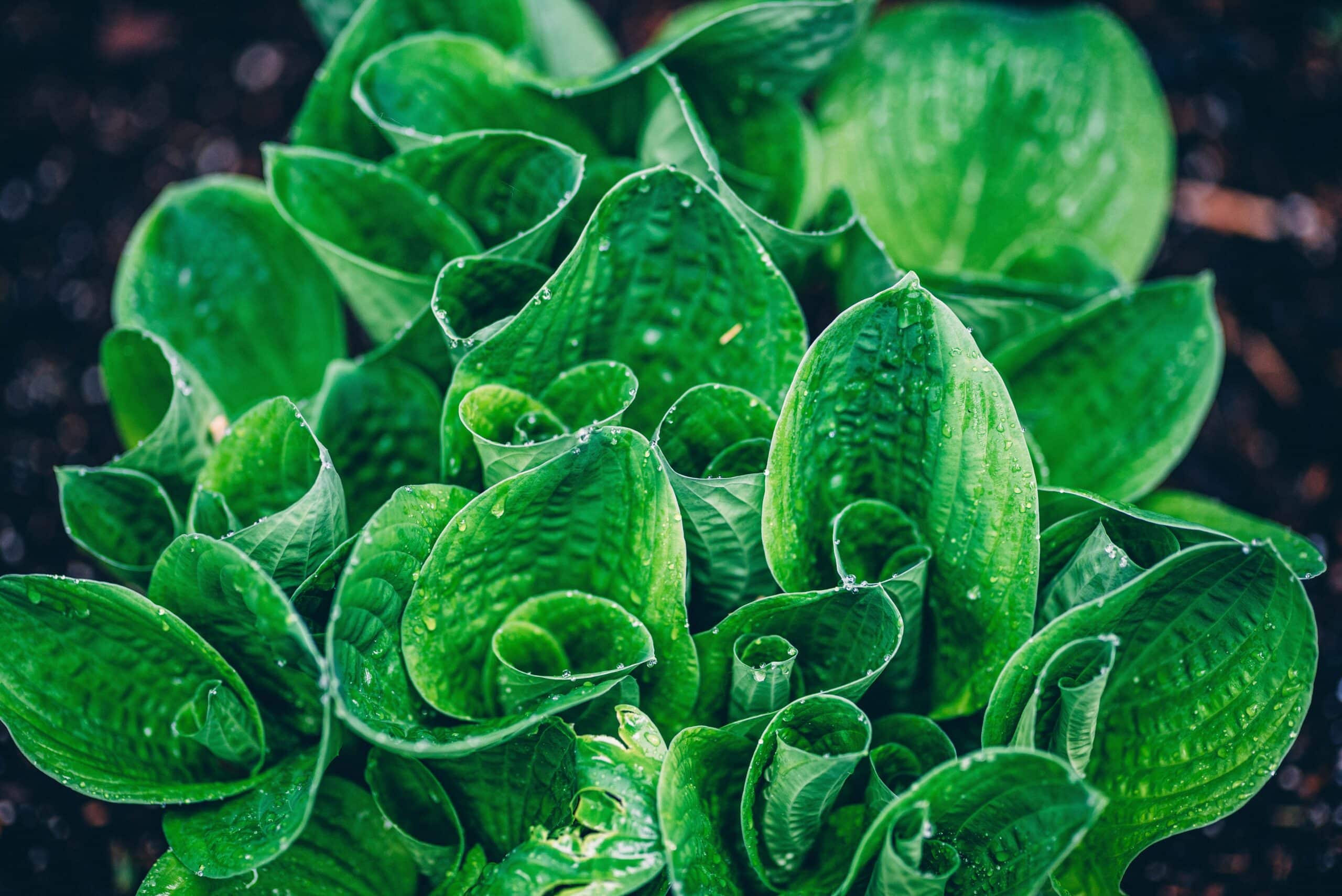Hostas are the shining stars of garden landscaping – their lush leaves, unique textures, and vibrant colors adding a touch of beauty to any outdoor space. But did you know that some varieties of hosta can actually survive in the sun? That’s right – these hardy plants can withstand direct sunlight and brighten up even the most exposed spots in your garden. In this article, we’ll explore which hostas are best for sunny locations and how to ensure their success once planted. So let’s dive into this world of sun-loving hostas and discover what makes them so special!
For those unfamiliar with this beloved perennial, hostas have been popular in gardens for centuries due to their easy-care nature and stunning foliage. Varieties come in a wide range of sizes, shapes, colors and textures – from giant monstera-like leaves to delicate lacey fronds – allowing you to create beautiful combinations in your garden. Hostas are also suitable for shady areas but surprisingly some varieties can thrive in full sun too!
These sun-tolerant varieties offer a unique opportunity to add texture and color to otherwise dull sunny corners or hot south facing walls. But it is important to note that there are certain considerations when choosing the right variety for your location – from selecting the correct size and type of plant, through to understanding how much water they need and when is best to plant them out. We will discuss all these matters here so read on if you want your sunny spot to flourish with wonderful hostas!
Understanding Hosta Needs
Hostas are like a lighthouse that guides us to the golden path of success. They light the way for us, providing us with directions we need to take in order to achieve our goals. But before we can use those directions, we must first understand what hostas need in order to thrive and grow in any environment.
Just like all living things, hostas have certain requirements for their growth and development – from soil moisture levels to sunlight exposure. In general, they prefer partial shade or full shade and moist soil so they can avoid wilting or drying out completely. However, some varieties are more tolerant of direct sun than others and can handle it with proper care and maintenance.
As gardeners, it is important that we recognize the differences between sun-tolerant and sun-sensitive hostas in order to provide the best growing conditions for them. This means understanding which varieties need more protection from direct sunlight or require extra water during hot summer days. By doing this, we can ensure that our hostas will continue to thrive despite whatever challenges may arise during their life cycle.
Identifying Sun-Tolerant Hostas
When it comes to growing hostas, it’s important to understand their individual needs. Fortunately, some varieties of hostas are sun-tolerant, which is great news for gardeners who want to enjoy the beauty of this type of plant in their sunny outdoor spaces. Here are some key points to consider when identifying sun-tolerant hostas:
- Sun tolerance levels vary greatly and depend on the variety.
- Leaf coloration and texture can also be indicators of how much sun a particular variety will tolerate.
- The amount of shade received by a particular plant should also be taken into account when determining its potential for sun tolerance.
- A general rule of thumb is that any variety with dark green leaves can tolerate more sun than those with lighter foliage.
Knowing the above information can help you narrow down your choices from the wide range available when selecting sun-tolerant hostas for your garden. With this knowledge in hand, you can now move on to exploring the many varieties of these plants that thrive in sunny conditions and add beautiful color and texture to your outdoor space.
Varieties Of Sun-Tolerant Hostas
When it comes to sun-tolerant hostas, the possibilities are seemingly endless. According to research, over 500 varieties of hostas can survive in full sun. This means that there’s a variety of options for gardeners looking to add some color to their outdoor living space.
To help you find the perfect fit for your garden, here’s a list of three popular varieties of sun-tolerant hostas:
• Patriot Hosta: This deep green hosta with white streaks is one of the most common types and is known for its resistance against slugs and other pests.
• Blue Mouse Ears: As its name suggests, this variety has small blue leaves and is perfect for adding a pop of color to any garden.
• August Moon: The bright yellow center of this hosta makes it stand out from other varieties and will bring energy to any garden space.
These three varieties are just a few examples of the many types of sun-tolerant hostas available. Not only do they add vibrant colors and textures to gardens, but they also require very little maintenance and care. With so many options available, it’s easy for anyone to find the right fit for their outdoor area.
As beautiful as these plants can be in direct sunlight, they still need some shade in order to thrive. In the next section we’ll look at why hostas need shade in order to flourish.
Why Hostas Need Shade
Ultimately, it’s essential to recognize why hostas need some shade in the first place. While the plant’s resilience and wide range of varieties make it a great choice for those looking to brighten up their garden, it is important to understand what makes them special. By understanding why they need shade, we can learn how to ensure their health and longevity.
One of the most powerful aspects of hostas is their ability to thrive in many environments, from full sun to deep shade. This means that if given enough protection from direct sunlight, like a canopy or partial shade, they will flourish with minimal effort. However, too much sun can cause the leaves to burn or wilt quickly as well as reduce blooming and prevent growth. This makes providing enough shade an essential part of caring for these plants properly.
Finally, by considering how much sun is necessary for hostas and planning accordingly, we can create joyful outdoor spaces that are conducive to the wellbeing of these remarkable plants while still allowing them the opportunity to thrive in partial sun conditions. With just a bit of care and knowledge about their needs, anyone can enjoy the beauty of hostas throughout the year.
Hostas In Partial Sun
“A little sun is good for the soul, and the same can be said for hostas”. With partial sun, hostas can thrive in places where full sun would be too harsh for them. The amount of sunlight a hosta receives will determine how much shade it needs to survive. It’s important to know what kind of light your hosta will receive when planting and caring for it.
Partial sun means that a plant gets at least four hours of direct sunlight each day. Some varieties of hostas can tolerate more than this, with up to six hours of direct or dappled sunlight each day. Many varieties of hostas prefer this type of light and will do best if given some sun exposure during the day. Other varieties are more tolerant of full-sun conditions and may even need some direct sunlight to perform well.
No matter what variety you choose, all hostas should have some protection from the intense heat of midday and late afternoon sunshine. If your plant is getting too much sun, you may notice leaf burn or wilting leaves; these are signs that your plant is not getting enough shade or water to cope with the heat. Move your plant to a shadier spot and make sure it has plenty of water throughout the summer months so it can keep growing strong!
Growing Hostas In Containers
Growing hostas in containers is a great way to enjoy the beauty of these beloved plants in a variety of settings. A great example of this is a friend who had no garden space, but wanted to add some color and texture to her apartment balcony. She found a large container, filled it with soil, and planted several varieties of Hostas that she was able to find in partial sun. The result was spectacular; the Hostas flourished and added life to her otherwise drab balcony.
Container gardening also allows for more flexible planting since you can move containers around as needed to adjust the amount of light each plant receives. This means you don’t have to limit yourself to just those varieties of Hostas that grow best in partial sun; you can experiment with different varieties until you find one that does well in your particular setting. Additionally, if your container dries out too quickly or doesn’t receive enough sunshine, you can always move it elsewhere — something that’s not so easy (or possible) when planting directly into the ground.
When growing Hostas in containers, make sure the pot has good drainage and use a quality soil mix specifically designed for container gardening. And don’t forget about fertilizing — it’s important for healthy growth! With the right preparation and care, you should be able to enjoy beautiful Hosta blooms in your container garden all season long — even when they usually wouldn’t thrive in direct sunlight. With their pretty foliage and vibrant flowers providing much-needed pops of color and texture, there’s nothing quite like it! As we move on to look at growing these versatile plants in sunnier climates, we can appreciate how creative approaches like container gardening help us make the most out of our gardens no matter where we live.
Hostas In Sunnier Climates
Ah, the challenge of growing hostas in the sun! What could possibly be more daunting? You’d think that we were asking for a miracle! But lo and behold, it’s not an impossible feat. Welcome to the seventh step in our journey to success with sun-loving hostas.
So what are the best varieties for hot climates? It turns out that there are many hardy cultivars of hosta that can thrive in sunny spots. For example, there’s ‘Sun Power’, ‘Frosted Mouse Ears’, and ‘June’ – all of which can handle intense heat and full sun exposure. Other varieties to consider include ‘Sum and Substance’, ‘Blue Angel’, and ‘Stained Glass’.
But it’s not just about finding tough plants; you also need to provide well-draining soil, adequate water, and enough shade to protect them from direct sunlight during the hottest hours of the day. With a bit of effort and care, you’ll soon have beautiful hostas thriving in even the warmest parts of your garden.
So now you know how to get started – but what about those living in even hotter climates? Well fear not: next up is our guide on growing hostas in the south!
Hostas In The South
Sizzling south hostas require special consideration. Sun-soaked southern gardens present unique challenges for growing hostas. Selecting the right varieties for your climate can be a tricky task, but one that pays off with beautiful blooms and lush foliage.
South-dwellers looking to add hostas to their garden should consider some important factors before investing in plants. Not all hostas are created equal, and some simply don’t thrive when exposed to direct sunlight. Knowing the right variety of hosta to choose is the key to success in the sunnier climates of the south.
When searching for a sun-tolerant variety, look for plants labeled as either ‘partial shade’ or ‘full sun’. Many of these varieties offer a wide range of colors and textures that will provide your garden with an extra pop of color and texture. For example, ‘Lemon Lime N’ Light’ has bright variegated leaves in shades of yellow, green and white that give it a unique look that’s perfect for sunny spaces. Hostas like this one can handle up to six hours of direct sunlight per day without any adverse effects. With careful selection and maintenance, you can enjoy vibrant blooms in even the hottest climates.
With proper research and care, southern gardeners can find success with hostas in even the sunniest locations. Selecting sun-tolerant varieties is the first step towards creating a thriving garden full of beautiful blooms no matter where you live!
Selecting Sun-Tolerant Hostas
When selecting hostas for areas with a lot of sun, there are several factors to consider. Sun-tolerant hostas need to be chosen carefully in order to ensure their success. It’s important to remember that just because a particular variety of hosta can tolerate sun, doesn’t mean it will thrive in it.
The first step is to identify the zone you live in and select varieties that are known to do well in your region. Next, make sure the hosta you choose is suited for the amount of direct sunlight it will receive. Most hostas prefer morning sun and afternoon shade, or dappled shade throughout the day. Additionally, look for varieties that have thick leaves as these will be less likely to scorch or burn in the sun.
Finally, consider the size of your garden space when selecting a variety of hosta. Some may grow too large if they’re placed in an area with too much sunlight and not enough room to spread out. To get started on finding the perfect sun-tolerant hosta for your garden, check out some online reviews from other gardeners who have tried them!
Preparing The Soil For Sun-Tolerant Hostas
Just as a gardener carefully prepares the soil to ensure that their plants thrive, it’s important to properly prepare the soil for sun-tolerant hostas. When done correctly, this process can help your hostas survive and even flourish in sunny conditions.
To create an environment for success, begin by digging up the soil in the designated planting area. You’ll want to remove any large rocks or debris and break up any clumps with a shovel or garden fork. Once you’ve achieved a looser texture, work in some organic material like compost or peat moss. This will help ensure that your hostas have access to nutrients that they need while also providing good drainage and aeration.
Next, you’ll want to test the pH of your soil with a kit from your local garden center. Sun-tolerant hostas prefer slightly acidic soils, so if your readings are too high, you can mix in some sulfur or gypsum to bring them down to the desired pH range. Finally, once everything has been mixed together thoroughly, it’s time for planting!
By following these steps and creating optimal growing conditions for sun-tolerant hostas, you’re setting yourself up for success when it comes time to enjoy their beautiful foliage in the coming months and years.
Planting Sun-Tolerant Hostas
The sun is a relentless force, often unforgiving and unyielding. To survive its harshness, one must be resilient and rooted deeply – the same goes for hostas. Planting sun-tolerant hostas is a step towards cultivating a garden full of vibrant colors, textures, and layers.
Sun-tolerant hostas require proper soil preparation in order to thrive in direct sunlight. The soil should be amended with organic matter like compost or peat moss to give it more structure and provide nutrients for the plants’ roots. It should also be tested for pH levels to make sure the soil is not too acidic or alkaline for the hosta variety you’ve chosen.
Once the soil is properly prepared, you can get to planting your sun-tolerant hostas. Make sure to follow planting instructions carefully; this will ensure that your plants get enough room to grow and spread their roots into the soil without becoming overcrowded. After planting, water thoroughly so that the plant roots are able to take in moisture immediately – this will help them establish themselves quickly in their new home.
With careful preparation and attention, your sun-tolerant hostas can provide lasting beauty and life to your garden – all while withstanding even the harshest rays of light!
Watering Sun-Tolerant Hostas
As we venture further along our journey to cultivating sun-tolerant hostas, it’s time to consider the importance of watering these hardy plants. Ah, the sweet smell of success; with proper care and attention, there’s no limit to what we can achieve!
Watering sun-tolerant hostas is essential for them to thrive in warm temperatures and direct sunlight. To ensure your plants receive an adequate amount of moisture, the soil should be kept consistently damp but not soggy. Additionally, it’s important that you water your hostas evenly throughout the growing season.
One of the most effective ways to provide water is by using a soaker hose or drip irrigation system. These systems allow you to deliver moisture directly to the roots of the hostas without risking over-watering or runoff. Furthermore, these systems are easy to install and don’t require any special tools or expertise.
Now let’s see how we can take our sun-tolerant hostas from good to great by providing them with vital nutrients through fertilization!
Fertilizing Sun-Tolerant Hostas
Fertilizing sun-tolerant hostas is a fundamental factor for their success. Feeding these plants the right nutrients can help them thrive in bright and sunny spots, despite their reputation as shade-loving perennials. For those looking to maximize their gardening game, here are some tips on how to fertilize these hardy plants.
As any avid gardener knows, amending soil with fertilizer helps feed and nourish the plants within it. For hostas, this means ensuring that there are plenty of nitrogen-rich components in the soil mix. Organic materials like composted leaves or manure will provide these necessary nutrients for hostas grown in sunny areas. Additionally, slow-release granular fertilizers can be used to give hostas an extra boost of nutrition throughout the growing season.
For gardeners looking to use liquid fertilizers, they should be applied every few weeks during periods of active growth. It’s important not to overfertilize—doing so can lead to too much leaf growth at the expense of flowers or roots and can put the plant at risk of burning out in hot weather. Instead, less frequent applications will help ensure that hostas have enough food without becoming overwhelmed by too much nutrition at once.
With proper fertilization and care, even sun-tolerant hostas can survive and flourish in brighter environments – all while still adding beauty and texture to any outdoor space! And with these tips in mind, you’ll be well on your way towards protecting your sun-tolerant hosta from any potential harm.
Protecting Sun-Tolerant Hostas
Surprisingly, some hostas can actually thrive in the sun! It’s important to properly protect them from the intense heat, however. With just a few steps, you can ensure your sun-tolerant hostas stay healthy and happy.
Did you know that almost 40 percent of all hosta species are capable of withstanding full sun? This makes them a great addition to any garden or landscape. Of course, it is important to remember that even these hardy varieties need extra protection from the hot summer sun.
There are a few key steps you can take to help your sun-tolerant hostas flourish in their sunny home. First, make sure they are planted in moist soil and that they get enough water during dry spells. Applying a layer of mulch around the plants will also help keep the soil cool and moist while shielding them from harsh sunlight. Additionally, consider adding shade structures like trellises or umbrellas on especially sunny days to provide additional protection for your plants.
By following these simple steps, your hostas will be well on their way to thriving in their sunny surroundings! Let’s look at what else we can do to ensure they get the care they need…
Caring For Sun-Tolerant Hostas
Caring for sun-tolerant hostas can be a challenge. Take the example of Janet, who recently planted several varieties of hostas in her garden. She was thrilled to find that they not only tolerated full sun, but flourished in it! But maintaining healthy and vibrant plants requires more than just planting them in the right location.
In order to keep her hostas looking lush and beautiful, Janet has to take extra precautions when it comes to caring for them in the sun. This includes ensuring that the soil is well-drained and fertilizing them regularly with a balanced fertilizer blend. Additionally, she needs to water her hostas frequently so that they don’t dry out and suffer from dehydration.
Janet also needs to pay attention to how much sunlight her hostas are receiving. Too much sun can cause them to wilt or become stressed, so providing some afternoon shade during the hottest part of the day is important. With proper care and maintenance, Janet’s sun-tolerant hosta plants will thrive for years to come!
Frequently Asked Questions
How Much Sun Should A Sun-Tolerant Hosta Receive?
Just as a flower needs the right amount of sunlight to grow, so too does a sun-tolerant hosta. We can think of it like a garden puzzle: finding the perfect balance between bright and shady spots. Too much sun can cause these plants to wilt and burn, while too little can leave them looking droopy and weak.
When deciding how much sun your hosta should receive, ask yourself these questions: How much direct sunlight does my garden get? Is there enough shade for my hosta? Do I have other plants nearby that will provide some protection from intense sunlight? Once you’ve answered these questions, you’ll be able to determine the best course of action for your garden.
Finding the perfect spot for your new hosta is like searching for a hidden treasure. It takes time, patience and trial and error, but when you find it – you’ll discover that your garden has come alive! To ensure success with your sun-tolerant hosta, remember this simple TIP: Test different areas before planting to see which one offers the right balance between light and shade.
What Should I Do If My Sun-Tolerant Hosta Is Not Thriving?
If you’ve planted a sun-tolerant hosta in your garden, but it’s not thriving, don’t panic! There are easy steps you can take to help your hosta survive and thrive.
First, make sure that the plant is receiving enough sun. Sun-tolerant hostas require at least four hours of direct sunlight each day. If your hosta isn’t getting enough sun, consider relocating it to a sunnier spot.
Next, water your hosta regularly and deeply. Make sure the soil is evenly moist and avoid overwatering; too much water can cause fungal diseases or root rot. If you’re in a hot climate with frequent droughts, consider mulching around the base of the plant to help retain moisture between watering sessions.
Finally, fertilize your hosta every few weeks throughout the growing season to ensure it has all the nutrients it needs for growth and flowering. Look for an organic fertilizer with balanced levels of nitrogen, phosphorus, and potassium for optimal results. With these simple steps and some patience, you’ll have a healthy sun-tolerant hosta in no time!
Are There Any Other Plants That Can Be Planted With A Sun-Tolerant Hosta?
Are there any other plants that can be planted with a sun-tolerant hosta? Absolutely! When creating a garden full of sun-tolerant hostas, it’s important to think about companion planting. By adding complementary plants to the mix, you can create a more vibrant and diverse garden.
One great option is ornamental grasses. These look beautiful when planted with hostas and add texture, movement, and color to your landscape. Some varieties of ornamental grasses even tolerate partial shade, making them perfect for gardens with both sun and shade spots.
For added color, consider planting daylilies or astilbe alongside your hostas. Daylilies come in shades of yellow, orange, pink, and red and bloom throughout the summer months. Astilbes are clump-forming perennials that produce feathery plumes of pink or white flowers in late spring or early summer. Both of these flowering plants will bring life to your garden while still allowing your hostas plenty of room to thrive in the sun!
How Often Should I Water A Sun-Tolerant Hosta?
Watering a sun-tolerant hosta is an important factor when it comes to keeping them healthy and thriving. Knowing how often to water your hosta is key to making sure they get the right amount of moisture without becoming over-saturated.
When it comes to watering your sun-tolerant hostas, there are a few factors you should keep in mind. Firstly, check the soil moisture before you add more water – if it’s already damp, you don’t need to water yet. Secondly, make sure the area around your hostas has good drainage so that any extra water can be absorbed quickly. Thirdly, the amount of water needed will depend on how much sun your plants receive throughout the day. If they’re getting lots of direct sunlight, they’ll need more frequent watering than those in shadier spots. Finally, if you want to be sure that your hostas are getting enough moisture, feel free to give them an occasional deep soak every week or two.
By taking into consideration these factors and following these simple steps for watering your sun-tolerant hostas regularly and properly, you can enjoy beautiful blooms year round! With proper care and maintenance, these hardy perennials can bring color and life into any garden – no matter how much sunshine they receive each day.
Is It Necessary To Fertilize A Sun-Tolerant Hosta?
Fertilizing a sun-tolerant hosta is an important part of keeping it healthy and vibrant. Alliteration helps us remember that fertilizing for foliage is fundamental for the flourishing of a fabulous flower. While many plants can thrive without fertilizer, hostas need additional nutrients to stay healthy in the sun.
A regular fertilizer schedule can help your hosta maintain its beautiful, lush leafy look. It’s especially important if you’ve planted your hosta in soil low in nutrients, or if you live in a particularly dry climate. When selecting a fertilizer, choose one with plenty of nitrogen to promote lush foliage growth. Be sure to follow the directions on the package carefully to avoid burning or damaging your plant.
Fertilizing sun-tolerant hostas is an essential step for keeping them looking their best and providing them with the necessary nutrients they need to thrive and flourish in sunny spots. With the right amount of care and attention, you can create a stunning display of foliage with fantastic flowers that will bring joy and beauty to your outdoor space!
Conclusion
In conclusion, sun-tolerant hostas can be a great addition to your garden if you have adequate sunlight and proper maintenance. Sun-tolerant hostas should receive 5 to 6 hours of direct sunlight per day, with partial shade in the afternoon. Watering once or twice a week is generally enough for this type of plant, and it may be necessary to fertilize it on occasion. When planting sun-tolerant hostas, it is important to consider other plants that can grow alongside them in the same area and provide the necessary shade for their survival.
Although many people are hesitant to invest in sun-tolerant hostas due to their delicate nature, they can be just as easy to maintain as regular hostas when given the right conditions. When planted in an area with ample sunlight and watered regularly they will thrive, creating beautiful foliage and lasting color in your garden year after year. With proper care and maintenance, sun-tolerant hostas will bring joy to any outdoor space while also providing visual interest.
By understanding how much sun these plants need, what other plants work well with them, and how often they should be watered and fertilized, you’ll be able to ensure your sun-tolerant hosta thrives. So don’t be afraid give your garden a splash of color with a few hardy sun-loving hostas!





























